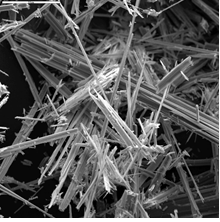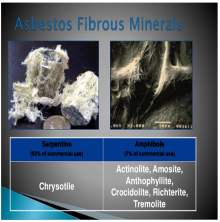The CSUSB Annual Asbestos Notification is provided for general campus information and to ensure compliance with California Health and Safety Code, Section 25915 et seq. as well as Occupational Safety and Health Administration regulations.
An asbestos survey was conducted on campus and has confirmed the presence of asbestos containing materials (ACM) in several campus buildings built prior to 1979. The survey identifies results by building name and additional unique identifying characteristics and locations.
The survey is available for review at the Environmental Health and Safety (EHS) Office between the hours of 8:00 a.m. and 5:00 p.m. Monday thru Friday. Contact the EHS Office at extension x75179 to make arrangements to view the survey. If you suspect a material in your area may contain asbestos and it appears damaged or in disrepair, contact EH&S.

What is Asbestos?
Asbestos are mineral fibers that occur in bundles that can be separated into thin, durable threads for use in commercial and industrial applications. The fibers are not only heat resistant but are also resistant to fire, chemicals, and do not conduct electricity. People get exposed to asbestos when they breath the microscopy fiber in the air. This fiber gets in the air when something disturbs the soil where the fiber lay. Deposit of asbestos fibers are naturally made; however, most of human exposure is due to commercial products containing asbestos. The amount of the exposure depends on different factors including location, type of material or soil asbestos is in, the age of the material, weather conditions and moisture, and amount of asbestos release in the air by the activity you are performing.
- Attic and wall insulation produced containing vermiculite
- Vinyl floor tiles and the backing on vinyl sheet flooring and adhesives
- Roofing and siding shingles
- Textured paint and patching compounds used on walls and ceilings
- Walls and floors around wood-burning stoves protected with asbestos paper, millboard, or cement sheets
- Hot water and steam pipes coated with asbestos material or covered with an asbestos blanket or tape
- Oil and coal furnaces and door gaskets with asbestos insulation
- Heat-resistant fabrics
- Automobile clutches and brakes

Health Hazards of Exposure to Asbestos
If disturbed, products containing asbestos pose a health hazard because of the tiny asbestos fibers that can be released into the air and when breathed in may get trapped in the lungs and remain there for a long time.. Several factors affect how exposure to asbestos can affect an individual exposed such as dose, duration, size/shape, chemical makeup of the asbestos fibers, source of exposure, individual risk factors, and genetic factors.
Serpentine Asbestos: Has long, curly fibers that can be woven. It’s the most commonly used in commercial applications.
Amphibole Asbestos: Has straight needle-like fibers that are more brittle than those of serpentine asbestos. They are also more limited in their ability to be fabricated.

Asbestos in a Classroom
- Pipe Installation: Asbestos in insulating wrap for heating pipes can be released if disturbed, during maintenance or construction activities
- Fireproofing: Spray-on coatings used as a fire retardant can release fibers during maintenance or construction activities
- Ceiling Tiles: Can release asbestos when damaged or disturbed
- Insulation: Used between walls - can be a problem if exposed
- Floor Tiles: Deteriorating floor tiles can release asbestos fibers
For disposal of all asbestos containing waste materials such as (debris, equipment, transite pipes, etc.) contact the Environmental Health & Safety Department to coordinate for proper disposal by calling (909) 537-5179.
California State University San Bernardino, CSUSB, is dedicated to providing a safe environment for its students, staff and visitors. Included in the safe environment is access to quality safe drinking water. Potable drinking water is provided to CSUSB from the City of San Bernardino Municipal Water Department. In accordance with Federal Environmental Protection Agency (EPA) regulations, the City of San Bernardino Municipal Water District publishes an annual Consumer Confidence Report that indicates levels of lead in the drinking water.
Please contact Environmental Health and Safety with questions regarding this report and questions about lead on campus at (909)-537-5179 for assistance.
What is Lead?
Lead is a highly toxic metal natural occurring element that can be found in all parts of our environment – the air, the soil, the water, and even inside our homes. Much of our exposure comes from human activities including the use of fossil fuels including past use of leaded gasoline, some types of industrial facilities, and past use of lead-based paint in homes. Lead has been commonly used in many household, industrial, and automobile products—such as paint, solder, batteries, brass, car radiators, bullets, pottery, etc. The Environmental Protection Agency (EPA) classifies lead as a probable human carcinogenic.
Lead Exposure
In the general population, lead may be present in small but hazardous concentrations in food, water, and air. Lead poisoning from deteriorating old paint is the primary source of elevated blood lead levels in children. Adults exposure to lead are less common; some of the sources included folk medicine, cosmetics, ceramic and metal cookware, and occupational exposure by breathing in lead-containing dust and fumes at work. Children under the age of six are at risk of developing cognitive health effects even at very low blood lead levels. Pregnant women or those who might become pregnant must avoid lead exposure because it is toxic to the fetus. Higher levels of lead in blood can damage the individual’s kidneys, blood, and nervous system which can progress to coma or death.
Lead Poisoning Prevention
Lead poisoning can be prevented when homeowners, tenants, and contractors know how to reduce or eliminate exposure to lead dust, deteriorated (chipping or peeling) lead-based paint, lead-contaminated soil as well as what danger signs to look for. For more information, contact the EH&S.